Ken gave us the music of animation overview in this speech.
First thing he mentioned is the power of a musical score. Music can create the lots of motion of the screen. It can make your film better or worse just depending on how you set it up and when you do it. Someone said that music can save your bad acting. Second, he talked about location, time area. There are three basic functions: one is play what you see; second is play subtext (not what you see) of character can be. Third is play against the action of a scene.
Ken also talked some worst things to music. For example, music can not be done to save a scene. Never too early to bring in composers. When talking to your composer, try to using emotional terms. Don’t try to speak in musical terms. What you need to do is let your composer know what you emotional feel or you think the audience should emotional feel about the scene. That is you talking about music for. Maybe play a CD or other scene from other picture but don’t tell them you want that music. Tell them this is emotionally what you feel. Give your composer a chance to react that and come up his/her idea. Never try to explain how they should do it. Let them work with sound.
Song of the story can set up your movie. Playing a song in the beginning and it can be considered a whole movie and develop your movie underscore. Never discount how you set up your first scene of movie. The same music can be playing as different things as tension, as trace, as love. There is no exception that all forms music is emotion.
Ken showed many clips of movie to explain what he talks about. He showed “Sum of All Fears” to mention first introduction of other sounds to the score. He showed “Mulan” to talked about the experience as a musical. Finally, there is one tip of animation about music or lyric Ken gave us: Do it. Animate to a piano, animate to what going to be, what tempo going to be. Write it down when you got some idea and you can trace that later. Don’t use material that you can’t use. That is a monster.
Sunday, December 9, 2007
Summarize of Ken
Friday, December 7, 2007
Bill Whittington's Sound Design and Science Fiction

To Bill Whittington, I asked, “Sound is crucial for the credibility of visual effects. How are sounds made stylized, iconic, and distinct for each film?” At first I thought I was asking a specific question, but as I read Bill’s book, Sound Design and Science Fiction, I realized my question pertained to the art of sound design as a whole. As a Critical Studies professor in the USC School of Cinematic Arts, Bill Whittington writes unique and important work as an author of film criticism, with a strong understanding in the art and practice of sound design.
His book, Sound Design and Science Fiction, details the development of sound design from the experimental work of Walter Murch and Ben Burtt, where the concept of a sound designer was conceived, to the highly crafted and creative work of Dane Davis. He discusses how after 2001: A Space Odyssey, audiences grew increasingly conscious of a film’s sound track in terms of genre expectations and the meaning it conveys. He describes Walter Murch’s work on THX 1138 and Ben Burtt’s work for the Star Wars series. For example, the character of R2-D2 communicates completely through rhythmic electronic sounds which function as a subliminal language. This character is the comedic relief for the series and his charm is carried not by his limited movement and expressionless face, but through his articulate and expressive sound effects ‘language.’
Whittington goes on to describe sound design used for thematic effect in films such as Alien and Blade Runner, where sound informs the audience about the character and the environment. In Alien, the mechanical spaceship is infused with the biological sounds of rain, heartbeats, and breathing. The sound of the ship conveys a sense of a living mechanical entity. In Blade Runner, the removal of the voice-over in the Director’s Cut completely changed the meaning of the character of Deckard. This version was much more successful. It demonstrates the importance of thoughtful sound design for science fiction films and other genres.
As the art of sound design grew and more films required special sound textures, technology also progressed to allow multi-channel presentation, where “sound could be hung in a room like a production designer would hang textiles on a set.” This enabled the sound design to immerse the audience in the environment of the film and direct the eye to the right part of the screen. Whittington gives the example of Gary Rydstrom’s work on Terminator 2: Judgment Day, where he uses bone crunches and breaks oriented to different parts of the screen to make the violence in the film hyper-real.
Finally, Whittington concludes his research with a look into the future of DVD’s, multi-channel home theaters, and video games. In terms of sound design and science fiction, he examines Dane Davis’ work on The Matrix. By knowing the history and practices of sound designers that came before him,
In my research of Bill Whittington’s work, I have learned to appreciate the changes in the science fiction genre from a B-picture status to the artistic merit it now enjoys. The book celebrates the spirit of experimentation that pushed the medium of film sound to the sophistication it has today. Sound design and visual effects are the main reasons why the cinema drastically changed after 2001: A Space Odyssey and Star Wars. As audiences became conscious of sound and had higher expectations of it, this required an artist who could specifically record, edit, and mix sounds that propel meaning into deeper realms and complete the experience of the spectacle. The sound designer brings credibility, insight, and impact to the film. For this reason, the sound designer is now an integral part of the collective art of cinema.
Wednesday, December 5, 2007
Tomlinson Holeman and 10.2
Tomlinson began his lecturing by talking about the revolution of sound in 1928 and how it changed the history of film and the lives of many. The way films were shot changed because the cameras had to be isolated due to their noisy nature and so everything that was filmed was static and almost theatrical. So with the advent of sound something else was lost in the process.
He began to do an illustration of the way sound can be perceived at it beginnings. The drawing is that of a small box and at its base is bounded by the frequency range, which is the range from base to treble. Treble was about all the details and during that time it was incredibly hard to get that sound off of film and back on to it again. The bandwidth or range of sound during that time was very limited and so the experience of sound was barely there.
The vertical part of the box represented the amplitude range, and that means the loudest sounds one can hear to the smallest sounds. This was also a very limited and dynamic range. During that time what sound engineers would do is play something very loud and then play something very soft and that way they contrast each other.
There were two dimensions to sounds back then and a third, the spatial aspect, was nonexistent. With the progress of history and war and so on sound started to get more developed and one of the people that set these advances in motion was Disney and his cooperation with the musical conductor Stokowsky. They began with the experimentation into stereo sound by 1934. That initiated the need for multi channel sound and “Fantasia”, 1939, was the first to do so. The channel at that time consisted of three only, left, right and center. So as it is known it was Disney himself who invented the idea of surround sound. The making of that system and its implementation at the time was very costly, limited, and sadly unsuccessful.
War world II happens and after that the popularization of television began and as a result less people began going to theaters and the industry crashed. The movie industry began to fight back and because of that many advances occur cinematically and also audio wise. By the eighties with the digital era sound advances happen also. In 1987 a committee of the Society of Motion Picture and Sound Engineers were asking how many channels needed to be on a motion picture print. Tomlinson’s response was 5.1, Left, right and center across the front, left surround and right surround and a single low frequency channel. The low frequency is needed because our ears cannot localize low frequencies well. By the time we get to this system the other two dimensions have been expanded and the frequency and amplitude range are in line with the audience and cannot be amplified any more than they already are.
5.1 was named by Holman in 1987 and came out on film in 1992 and became popular since then. What comes after this is the addition of more channels and from that comes the 10.2 sound system which is twice as good as 5.1. How far the number of channels can go is known and largely speculated but the most logical answer at the moment is 10.2.
The purpose of 10.2 is to allow much greater flexibility for sound designers and create a far more immersive environment for the audience. With these channels, it is possible to recreate the acoustics of nearly any location with astonishing realism. Holman found that the second most important sound wave to hit the audience - after the one from the source - is the one that comes from a point on the ceiling, halfway between them. This is because most rooms have hard and reflective ceilings, but the walls are semi-absorptive due to objects in the room; while the floor, usually covered with carpet, absorbs most of the reflected sound. So this first, overhead reflection reaches the ear at a slightly different time, allowing the brain to both localize the primary sound and compute the size of the room. By placing two speakers 45° above and to the left and right the audience, this key sound wave can be recreated. The other speakers can fill in the other major reverberations from the sides and off the back of the room, recreating a full acoustic signature. The strength of traditional 5.1 surround is that its left and right surround speakers are diffuse; they spread the sound around the entire area. This helps to prevent the " Exit Sign Effect" - audience members looking away from the screen at the source of a localized sound, not realizing it is part of the movie. However, this diffusion carries a cost in flexibility. Therefore 10.2 augments the LS (left surround) and RS (right surround) channels by two point surround channels that can more finely manipulate sound - allowing the mixer to shift sounds in a distinct 360° circle around the movie watcher.
The .2 of the 10.2 refers to the addition of a second subwoofer. The system is bass managed such that all the speakers on the left side use the left sub and all the speakers on the right use the right sub. The Center and Back Surround speaker are split between the two subs. The two subs also serve as two discrete LFE (Low Frequency Effects) channels. Although low frequencies are not localizable, it was found that splitting the bass on either side of the audience increases the sense of envelopment.

Web design
Monday, December 3, 2007
Mockup v2

John and I just went over this design, which will be cleaned up and finalized by tomorrow. The user will have the ability to go to a preset "station" (guests, research, projects, etc.) and then "tune" to individual parts of each. For example, one could go to the preset "Guests" and then be able to tune from Tom Holman to Ken Hall to Bill Whittington.
The two small blue screens will contain a station name and a faux radio call number. The large blue screen will contain up to two lines of description as to that station's content. Each of the stand-in red frames will contain different content depending on the station. For example, the "Guests" page could include a photo, a short bio, and the research summary on his work.
More updates coming very soon!
Site Mockup
Sunday, December 2, 2007
Site design 2
Thursday, November 29, 2007
The Musical!
But growing and certainly working in this industry and learning about the history of cinema I've come to appreciate it more. Musicals started way back with Fred Astaire and Ginger Rogers and Gene Kelly and so on they helped the American public suspend thier disbelieve and really immerse themselves in something delightful rather than indulge in post world wars tragedies and all the trouble of the cold war and other wars that followed. They soon died off and were not as popular and apparant as they used to be.
Interestingly enough they did appear back in the ninties in animation, and the question that was asked in class today is why did that happen. The reasons were that a lot of the producers and people working in the Disney animation studioes at the time really believed they could revive musicals through animation and the major factor was that they were all broadway producers and had that theater background to them and moved from that industury only because it was harder to make a living out of it and chose animation.
Until today those musicals in Aladin, or Lion King or any of those Disney classics still lives on and in this case they definitely bring back memories. They really pushed the genre at the time and the musical function in several ways, it really helped add to the story and conveyed the general idea and plot and even adds to the mood of the film.
Obviously that has died down a great deal and what was brought up during class was the idea of how muscials may not function so well in America but other parts of the worlds, and what's funny is that I asked an Indian producer why Bollywood continues to and remains through out their history creating the same types of films that are heavy with musicals and his response was that they worked as an escapesed tool. People watched those to cheer themselves up and forget about the depressing and harsh lives that they lived.
So it was interesting to think about the emotional aspects of music and how it certainly adds a great deal to the visual world of cinema regardless of the medium or setting.
Happy Birthday Song
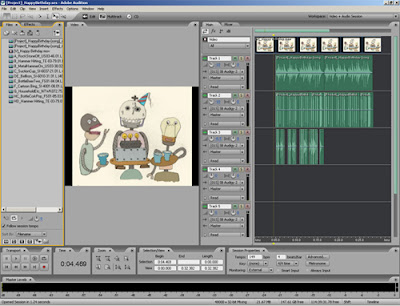 It is the first time I use Audition. Thanks for Jan's helping me how to make some sound effect that I want to do.
It is the first time I use Audition. Thanks for Jan's helping me how to make some sound effect that I want to do.As for my project, first I wanted to build the main melody (Happy Birthday song) with hitting sound. So I found sound from the library that might have some pitch. I heard those sound and arranged file name something like C-filename, D-filename, E-filename......and then when I edit the happy birthday song, I won't get trouble. When I want to put a sound Do, I could grab the correct file. I put some sound from hitting iron or metal hammer in Track 3 and tried to let them become the happy birthday song. Actually some work but some don't. So I put two simple happy birthday with real melody in the track. I think they can help audience to recognize it is a birthday song. I found these two birthday song form website. One plays in music box and the other is made by digital sound.
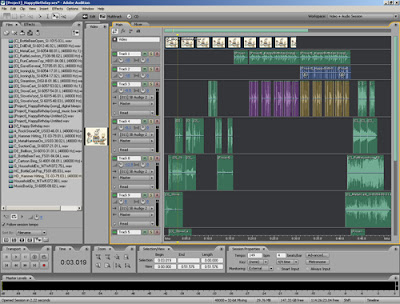 When I finish the main melody, I stared to deal with other environment sound. Those works are according to my picture- three robots holding a cake and drinks. In the beginning, I imagined they prepared things to celebrate. So there are sound I want them to feel like preparing somethings in a flurry. Then robot A starts singing happy birthday song but robot B stops it. Robot B plays the music box, and then three of them sing together. When the song finished, there are sound I want them to feel like cheerful.
When I finish the main melody, I stared to deal with other environment sound. Those works are according to my picture- three robots holding a cake and drinks. In the beginning, I imagined they prepared things to celebrate. So there are sound I want them to feel like preparing somethings in a flurry. Then robot A starts singing happy birthday song but robot B stops it. Robot B plays the music box, and then three of them sing together. When the song finished, there are sound I want them to feel like cheerful.Yesterday Jan suggest me put some ambiance sound in the background. I try to find some that can fit in this piece, however I don't think I find the great one. Finally I put an ambiance about household in the background but the volume is small.
I put the file that I mix down in my file of Sound and Consciousness Group already.
I think I done this piece . Then I will try some sound postcard about Taiwan but I didn't come up a good idea yet. So, keep working.
Wednesday, November 28, 2007
Site Design
Coagula
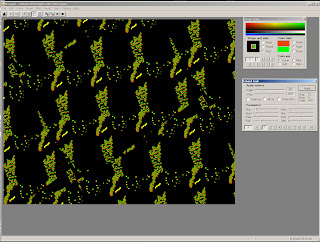
This is a screen grab from a interesting piece of software I discovered called "Coagula." This allows you to "draw" sounds. The types of sounds are somewhat limited because it creates digital scrambles of tones and pops and noise. However, used in the right way, I think the program could produce really amazing results. We had a visit from sound designer Dane Davis who said he used high-end programs like this while working on the 'Matrix Trilogy' and other films. In terms of science fiction, the program can really enhance the process of creating abstract sounds by giving you a way to intuitively create them through drawing. From reading Bill Whittington's book, 'Sound Design and Science Fiction,' I appreciated the careful attention given to the sound of the character R2-D2. This is a character that has no facial expressions and very limited movements, but through the development of a digital language by Burtt, is one of the funniest characters in the 'Star Wars' films. It would be interesting to develop more of a sound language using Coagula.
The Conversation Grows
Malak, I appreciated your honesty regarding your fear of working with sound, but it seems that you're growing past your fears and I'm sure your films will be even better as a result. For your creative piece, I liked your description, but one thing stuck out which might help to develop it further. You said that sound can be used to create memories. This was interesting in terms of your project, because each of the three frames could represent a different memory. For example, with the shot of the mouse, you could add background layers to your soundtrack that could allude to a funny old computer game like "Carmen SanDiego." I definitely think you need to work with more layers in the piece and this will help you to achieve an experience.
Tuesday, November 27, 2007
Sound and Image

Sound and Effects
I first started by adding this instrumental track to my piece and worked on editing it so that it fit with the emotional lows and highs of the piece. Before taking this seminar class and researching music I would have been absolutely fine with just turning in my piece that way. I created an animation with a beautiful track to accompany it. The problem is that I started to realize that it was lacking and I’ve come to appreciate sound and realize that it really does lend a great deal to any visual piece.
What I had initially was two components to my animation the obvious visuals and an obvious sound track and nothing in between. My animation actually reminded me of the older films made before the advent of sound. It was like watching a film and I could almost imagine someone with a piano accompanying it.
So I proceeded to add sound effects, which I honestly have a great deal of fear in doing. I have this paranoia that it will take away from the sound track. I also don’t know anything about technically editing sound which is probably why I’m so hesitant when it comes to this part of the filmmaking.
The surprising thing for me was that adding the sound effects actually helped the piece and the track was not lost at all and if anything adding that layer cushioned both the visuals and the sound track and I feel like it all blends together a lot well.
My first scene involves a pan down on this outdoors environment and a caterpillar crosses a tree branch and a girl pops up and looks at it. The sound track starts off with this soft playful piano melody and the visuals only. I then added ambient sound of birds chirping, wind, trees and leaves rustling which brought the environment alive and effects for the caterpillar as he crosses and he also came to life. The moment I added the effects I felt like the caterpillar really moved rather than just stimulating the visual sensory I was having a full experience.
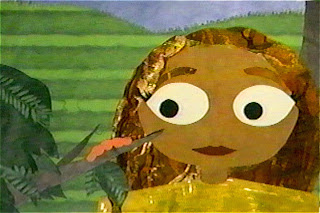 The second scene worked much in the same way. I added the sounds of her crying and the flapping of the butterfly’s wings and kept the environment sound playing in the back. The sound effects here helped add to the scene what it’s lacking. My animation is very limited and without the sound effect of her crying the audience would not be able to tell how she is feelings. So the sound effect here helped convey what I couldn’t visually.
The second scene worked much in the same way. I added the sounds of her crying and the flapping of the butterfly’s wings and kept the environment sound playing in the back. The sound effects here helped add to the scene what it’s lacking. My animation is very limited and without the sound effect of her crying the audience would not be able to tell how she is feelings. So the sound effect here helped convey what I couldn’t visually.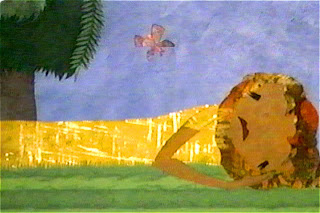 I’ve certainly developed much more of an appreciation and less of a fear towards the creation of sound for film.
I’ve certainly developed much more of an appreciation and less of a fear towards the creation of sound for film.Response to Sound creation in "Saving Private Ryan"
Monday, November 26, 2007
Happy Birthday Song
Here are sounds or music I want to use.
-Happy Birthday Song (Music Box)
-knock/punch/bang iron things
-a sound when a lamp light on
-clock
-knock wood door
-Bottle Beer Open
-hammer hitting
..................................some sounds like that.
Sunday, November 25, 2007
RE: Feedback
As for the size of images, they should be smaller for the web: As of now the radio UI is 1024x768. The nested clips are smaller. Right now my project is 550x400. If you would like another standard please let me know.
Posted to hal in my section of the group folder.
Website Feedback
Fruits of Labor
I went with the idea of an antique radio system. I know we have to add some more things to the site, but this is a good starting place. Any feedback would be superb! There are still a few kinks, but my project has already been incorporated and is fully interactive.

Saturday, November 24, 2007
Grayscale Carnival Environment (In Progress)
It has been a difficult task to work in a very, very narrow range of gray colors. The idea is to keep the user in the dark visually, but use a great deal of sound cues to simulate environment.
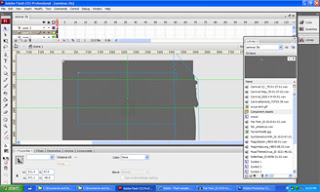
There will be another interactivity trigger that is being worked on as I report. The basic concept is that there will be small points of interactivity that must first be "discovered" in order for the user to begin to understand the environment. The reasons that larger ones were forgone is because if the "hit zones" become too large then the subtlety is lost.
Sound and Music in 'Saving Private Ryan'
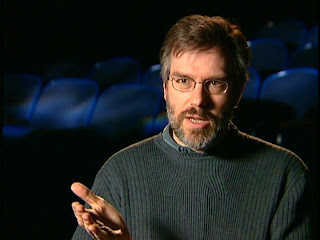
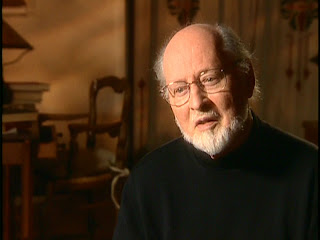
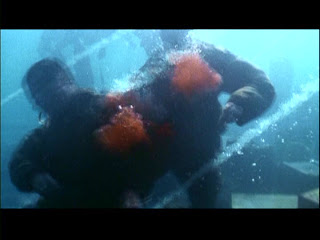
One of my classmates recommended that I watch a short piece interviewing John Williams and Gary Rydstrom about the making of the music and sound on the Saving Private Ryan DVD. In a short piece they both explained important elements central to the research of our group this semester.
John Williams has worked with Steven Spielberg on most of his films. When working with Spielberg, he prefers to see the film in its final stages rather than read the script ahead of time. For 'Ryan' Spielberg and Williams agreed not to use music during the battle scenes, but rather to keep them realistic. Williams wanted to focus on moments where the music would strike an emotional chord. For this, a choir was integral to the orchestra. Williams worked with the Boston Symphony Orchestra in the Boston Symphony Hall. As a side note, this particular music hall is one of the favorites of our guest, Tom Holman, who revers the acoustics in the Boston Symphony Hall as 'one of the great music halls in the world.' One thing I found interesting was in Williams' description of the Hymn to the Fallen which is the piece that closes the film. He said that it was a requiem for the people lost in the war. Often Williams composes for films by starting with the ending piece and then separating the ending and having threads of the ending running throughout the film. The threads of the music collect in the ending.
Gary Rydstrom has often been discussed in our research for creating the roars in Jurassic Park. However, I think 'Saving Private Ryan' is interesting for our research because he had to achieve a degree of realism so the film could be true to the memories of the people who were in it. He loved the opportunity to work on a war film that didn't have music in the battle scenes. Rydstrom asserts that anytime there is a score in a film, the audience feels like they're watching a movie. Without a score dominating the battle scenes, he was able to craft the scenes to be much more visceral. For example, the opening battle scene on Omaha Beach 'pulls you in and has you experience the battle in a very direct way.' Sound design guides the visceral experience. Spielberg told Rydstrom that he didn't want the sound to 'be Hollywood.' Rydstrom explains that this meant not using existing sound libraries, cliches, cheats, etc. This required the sound designer to do research by studying guns and weaponry and interviewing veterans to hear their experiences of the war and what it sounded like. He was surprised to learn how much of their memories were driven by the sounds of the battlefield. For example, the Germans listened for a particular 'ping' that came from ejecting an empty shell cartridge from an American gun. The Americans simulated these 'pings' to lure the Germans out from hiding. Through these 'revelatory' interviews, Rydstrom became passionate about achieving sound design that was true to their memories.
In the beginning of the film, in the Omaha Beach scene, Rydstrom wanted to recreate the experience of being shot at. For this scene he broke the scene into important elements. The most important elements were bullet impacts. For the pre-mix of the bullet impacts he had cue sheets stacks thick as phonebooks.
The Omaha Beach scene contains moments in the water where the camera bobs above and under water. Rydstrom took the opportunity to create contrasting perspectives above and underwater. Above water the battle rages and Rydstrom describes it as ' chaos and cacophony.' Underwater the cacophony goes away and the water becomes safe, like a cocoon. By placing these two perspectives in contrast, Rydstrom is able to unsettle the viewer when bullets pierce into the cocoon and kill the soldiers. For the sound of bullets piercing underwater, Rydstrom demonstrates using an un-horrific sound for horrific effect. He used the sound of a fly-fishing line being ripped out of the water, which he had saved from A River Runs Through It.
In terms of Sound and Consciousness, Rydstrom discusses scenes where Tom Hanks' character becomes shell-shocked. In these scenes, amidst the battle, the sound is taken out of the battle into Tom Hanks mind, creating an abstract expression and a window into the traumatic state of mind. According to Rydstrom, 'Taking the sound out of the battle became an interesting device to get inside someone's head.' Rydstrom had to imagine what it would be like to hear the sound of yourself. He remembered the experience of listening to a sea shell. "What you hear is an echo of the world around you, roaring in your head." To simulate this, Rydstrom recorded sounds of the ocean, then played them through speakers and re-recorded them by placing the microphone inside a long tube. This made 'a resonant shell sound.' Furthermore, Spielberg had the brilliant idea to conclude the interior experience with a high-pitched tea whistle that zapped the viewer back into reality. This proved to be really effective. In the final battle, the sound design returns to the effects of shell shock for Tom Hanks' character. Rydstrom manipulates the perspective in order to let the viewer see through this character's eyes. This effect allows us to identify with this character even more.
In the final battle, German tanks approach the few American troops still alive in the French town. During the night, they hear quiet, distant rumbling, like distant thunderstorms, from battles being fought miles away. Again, Rydstrom had to do research to achieve the effect he wanted. He found real recordings of World War Two battles and discovered they had the 'storm' quality to them. When he added the final layer of this distant rumble, he felt he had achieved a sense of reality and depth with the intricacy of the war in close perspective and also the sounds of the war on the horizon. This consciousness of sound delivers a profound sense of the scale of this war. Furthermore, in the final battle, the sound design changed to build on the tension the soldiers felt as the tanks approached, rather than the plunging in we experience of the Omaha Beach scene. For some time as they wait, we only hear the tanks approach. Spielberg referenced the film Zulu and required Rydstrom to study a particular scene where the Zulu warriors encroach on a British fort. Spielberg didn't want a copy of that sound, but he wanted the sound design to capture the feel and the essence of it. When the tanks arrive, Rydstrom created the sound of the tank wheels, squeaking and churning all from scratch. He played a selection of random sounds on 1/4 in. tape and reversed and slowed the sounds to create wild echoes simulating the clanging, rumbling tank bodies.
Studying Gary Rydstrom's work in 'Saving Private Ryan' directly to relates to Bill Whittington's research on sound design. All of the methods and philosophies of sound designers like Walter Murch are present in Gary Rydstrom's research, techniques, and thematic attention to detail. John Williams music for the film is also a great compliment to the presentation given by our guest Ken Hall. The music is selectively used to generate elegant moments of reverence and retrospection.
Friday, November 23, 2007
Adobe Soundbooth
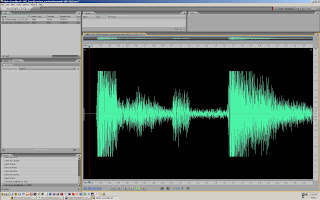 Adobe Soundbooth for CS3 is a new sound-creation, composing, and sound designing package. At first I expected a direct replacement of Adobe Audition, which I understand is being modified. Soundbooth allows you to manipulate individual sounds by the ability to push the sound through a series of different effects. From my current research, I see the program as Photoshop for sound. I tried a few tests with a sample of sound from the construction site of the new Lucas Building here at USC. This is a great tool for a sound designer, because one can put a lot of attention into single sounds to stylistically treat them for a piece. As of now, my pipeline will take sounds recorded in the field, then I will manipulate them in Soundbooth, and finally I will layer, edit, and mix them together in Audition. I will follow the same path with pieces from Loopoly to create my own version of a "Sound Postcard."
Adobe Soundbooth for CS3 is a new sound-creation, composing, and sound designing package. At first I expected a direct replacement of Adobe Audition, which I understand is being modified. Soundbooth allows you to manipulate individual sounds by the ability to push the sound through a series of different effects. From my current research, I see the program as Photoshop for sound. I tried a few tests with a sample of sound from the construction site of the new Lucas Building here at USC. This is a great tool for a sound designer, because one can put a lot of attention into single sounds to stylistically treat them for a piece. As of now, my pipeline will take sounds recorded in the field, then I will manipulate them in Soundbooth, and finally I will layer, edit, and mix them together in Audition. I will follow the same path with pieces from Loopoly to create my own version of a "Sound Postcard."
Image and Sound Relationships
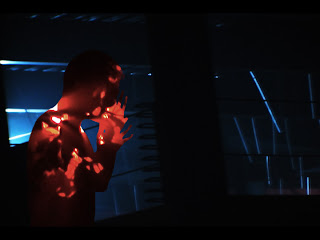
In Bill Whittington's Book, Sound Design & Science Fiction, he thoroughly describes the role of a sound designer. For my final project, I would like to further develop these concepts into a short project. Sound designers like Walter Murch and Ben Burtt rejected the use of sound libraries. They created a pallette of effects for each film. In his work on THX 1138, he recorded sounds on construction sites, airports, zoos, and more to describe the futuristic and psychological world of THX.
In the Contemporary Topics class, Prof. Kathy Smith had students create abstract imagery, combining it with originally designed "Sound Postcards." Many of the 'postcards' featured a musical element to the sound design like a classmate singing. This relates to one of Murch's philosophies on Sound Design in that the sound designer is composing a piece, highly aware of the musical characteristics of each sound. High and low frequencies can play off of each other and quiet and loud contrast is the most important relationship in creating tension.
Wednesday, November 21, 2007
Interactive Sound and Sound Environments
John's creation of a carnival environment will be interesting, especially if he develops subjectivity into the experience of a carnival. For a child, a carnival can be a wonderful, happy place, but for a deranged or paranoid person, the environment can quickly become a nightmare. Have you decided any particular perspective for the environment?
Saturday, November 17, 2007
"Kuleshov" project
Hard Effects
-car screeching (intense)
-glass breaking (intense)
-thunder (intense)
-clock ticking (neutral)
Ambience
-birds chirping (peaceful)
-wind blowing (neutral)
-city streets (neutral)
-underwater (neutral)
Dialogue
-wallah (neutral)
-woman's scream (intense)
-baby crying (intense)
Here are the images I'll be using:
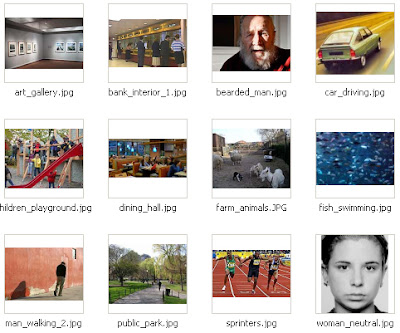
-Brian
Friday, November 16, 2007
Sound As Environment
I found a bunch of interesting materials. The barkers (the fellows who always yell "Red Hots! Get yer Red Hots!" will add another dimension to the piece. The visual elements will be limited to a very tight grayscale range. This will necessitate the usage of sound as the dominant element. The user will then have to determine the environment.
Sounds:
Calliope (entrance to the big top)
Barkers
Crowd Cheering
Game noises
Some game noises
Wednesday, November 14, 2007
Adobe Audition
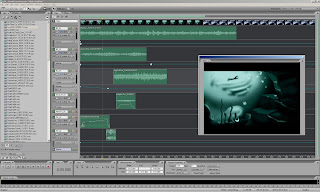
Here is a screen-grab from my current work. I am designing a subjective underwater environment. Thinking of the layering techniques used in science fiction sound design, I am trying to process music from loopology to create certain sounds. For example, I found an ambient, albeit electronic choir tone. By stripping it down using the Scientific Filters, I was able to create a thin cue that adds mood to the basic underwater ambience that I took from our sound library. More to come...
Leit Motif
Tuesday, November 13, 2007
Pearl Diver Sound Idea List
BG/Ambience:
Underwater ocean ambience
Muffled Bubbling
Low-Freq throbbing
Digeridoo
Hard FX
Splashes
Exhaling
Man straining to hold his breath
knife into can
can opener
suction releasing
rocks tumbling
Music/MX, from Adobe Loopology
Drum/Bell Jingles
Gong - pitch-shifted high
Monday, November 12, 2007
Pearl Diver
Wednesday, November 7, 2007
Tuesday, November 6, 2007
Dream Landscapes
Wednesday, October 31, 2007
Final project concept

The user can scroll over an image and hear the sound play, and see what s/he feels from the combination of sound and image.
I'll get better image and sound ideas for the next iteration...this was just a quick runthrough.
Brian
Monday, October 15, 2007
More Questions
Well my question is related to what Jean was saying in a sense. With the advent of new technology there always seems to be something that is left behind or translated differently in its new form, so with the creation of this entirely immersive sound system, 10.2, what are some possible disadvantages or set back that may occur?
Is an exchange program needed where composers, sound editors and engineers all join together to learn and help create a sound environment using the 10.2 system?
Kenneth Hall :
To me the idea of emotions is that it is a very directional thing. We see something directly and automatically we have a reaction, what we don't see yet hear depending on the sounds can enlist fear in us and so on, so with the advent of this surround sound how do you think it will effect the audience, and your creation of provocative music? Do you think it is an enhancement and what are the measure you can take from this and expand on?
Bill Whittington:
There is this concept that all our ideas have been taken and everything that is currently created is only an appropriation and an altered state of a previous idea, does the same go for sound? Have we heard everything and how do you create something completely new ? How do you introduce it as something new when we have such a complex data base and are always trying to recognize sounds and associate it with what we know ?
My question for our guests
-In real world, when a sound comes form our back or somewhere we don’t noticed, we often turn to the direction where the sound is to see what is happened. Your 10.2 sound system can perform sound just like the real world. When it is used in a theater, won’t it become a disturbance to audience? Because in a theater the screen always in front of us. If audience hear some sound and turn their heads to other place, they will miss some scenes.
Ken Hall
-You edited lots of movie’s music. There are many kinds of movies and animation (Mulan). When you edit music, is there any different between live action and animation?
Bill Whittington
-When you design sounds that audiences never heard before, did you do many kinds of experiment at the beginning? How did you know that kinds of sound can work for audience?
I'm not sure is the meaning of the question be convey in right direction or not. My sentence might not good to understand. Please correct me if there is something wrong.
Thanks,
Jean
(drumroll) More Questions..
Immersive sound is an evolving concept. Currently, the 10.2 Sound System is the pinnacle of that technology. How do you envision the evolution of immersive sound? To be more poignant, where do you think this technology will have its end? 20.2, 30.4? How many sound channels are necessary to replicate a true sound environment? One that mimics our every day lives?
Kenneth Hall:
As a sound and music editor, you have a lot to do with how a piece is presented/received within the context of the movie. How do you seek to evoke emotion through sound? Do you subscribe to a set of conventions when editing? Like the villain's theme must always be drawn out with emphasized percussion? Or do you let each specific project take on a life of its own though communications with the director and composer? Or is there a balance between the two? Are some situations demanding a more traditional approach?
William Whittington:
The creation of sounds is an art in its own right. Playing off Brian's question, how much of cinematic sound creation involves being true to the source of the sound and how much of your endeavors lie in making something sound good for film? Furthermore, how do you attain the equilibrium in which something sounds really cool, but the audience deems it as appropriate? Do you test these sounds with different people to see if it works or do you just know instinctively when something is working?
Wednesday, October 10, 2007
Questions for Our Guests
-With the continued evolution and improvement of visual effects over recent years, the human eye has becoming more discerning with falsified visuals in movies and television - "breaking the fourth wall," in a way. How do you see your 10.2 sound system and other immersive sound technologies keeping audiences within the experience, and avoiding "breaking the fourth wall?"
Ken Hall
-Music clearly informs the audience of mood and tone throughout a film. Do you project your own emotions through your music in order to evoke similar feelings from the audience who will be hearing it?
Bill Whittington
-When creating sounds for real objects and environments that most audiences have never actually experienced, such as being in a submarine or in a spacecraft, where do you base your decisions in order to make the sounds convincing to the average listener? In other words, how much is based on fact, and how much is created from your imagination?
"Ripley, they're playing OUR song!"

brief idea
If we're going to do a sound space involving the way a dog (for example) hears, we could do a human/dog comparison using the exact same sounds and timing, but with different mixing to show the dog's enhanced perception.
Anyway, on to questions for our guests next week...
Brian
Believability
I believe if we can add this "layer" of depth to the project we'll achieve the goal of Sound Consciousness. This will dive deeply into the idea of ambient sound as those that truly flesh out an experience.
Monday, October 8, 2007
Interviews with Tomlinson Holman
Someone else interview with Tomlinson before.
Sorry, I fix it.
http://portal.acm.org/citation.cfm?doid=1037851.1037867
I hope it can work for us.
Wednesday, October 3, 2007
Layers
I had the idea of just a simple ball bouncing in a room and just the sound effects we add to that can change the type of room and environment is it in.
We can have an intance where we grass rustling, birds chirping and the sounds of the balls at it thuds against the grassy ground and that way we've put the ball in an outdoors sort of park environment.
Another instance is that of having the ball fall again in a room but if we add the sounds of people walking around, and a hard surface that feet hit against and then have the ball hit the ground which could be made out of floor and now that same ball animation has been transformed into a different environment.
The texture and weight of the ball itself can be changed just by changing the sound too.
Sound just like images I've realized have layers, and we can have background, midground and forground sounds in a sense.
This is definitly the way that sound should be incorporated into every peice we do wether they are microcells or even conversations people are having.
Sunday, September 30, 2007
Conservation




This week's Animation Seminar was very interesting for me as a cinematographer and visual artist. The lecture given by Dr. Judith Hirsch taught me some of the amazing properties of the eye. The eye is most sensitive to movement, contrast, and hard edges within an image. Scientists discovered this by measuring the electric impulses from the retina to the optic nerve. I will work with these properties in my thesis because I am working with shadow puppets which center on the use of contrast.
My animation and my sound design for the project will center on promoting conservation of endangered animals. I will pick a subject like a frog, a panda, a chinchilla, etc. and do a cut-out animation piece about the animal. My animation will be limited, but I will develop a few 'style frames' and develop the sound environment portrayed in the frame. My sounds will include narration and sound effects that describe the animal's environment and maybe what aspect of humankind threatens its extinction.
Thursday, September 27, 2007
Recent work
Brian
Wednesday, September 26, 2007
sound vs. image
Looking forward to fleshing out a bit of a storyline, see you guys soon!
Brian
This wax is serious

Synergy
I like the ideas we're coming up with now! Jan's idea of a microscopic environment coupled with Malak's idea to produce sounds that trick the mind would be solid additions to the psychological aspects of conversation that Brian chose to post about.
Sound Consciousness says a few things to me.. Firstly, that this project and presentation should be dominated by sound aspects (mixing, effects, et al) and the visual references (characters, environments) should be subordinate to the sound.
I like creating an environment (microscopic or otherwise) in which a the user is not familiar. Many of these sounds will have to be interpreted because there is no way we can know what they are... Furthermore, the visual style should be very controlled (via the colors, or even lack of picture) so as to not "tip our hand". We want to play with the audience's mind a bit because what they think is one sound will definitely not be what they expect!
Perhaps this environment can be in the ear? We'll let Brian decide... The microbes can be characters perhaps? I know Jean was working on neat fish creatures.. Fluid/liquid environments totally change the way sound is represented so I know we will all have fun with that... AND, if you want, each piece on the screen can be contributing layers to the overall "sound" of the environment and can enter/exit the field in such a manner where the effect on the total sound environment a la "The Conversation".
Tell me what you think!
Tuesday, September 25, 2007
Strength and Honor
I am well versed in Flash, Dreamweaver and Illustrator. For the majority of my 2D works I have combined these tools together to create (in my opinion) solid pieces.
 This screen was captured from a Flash structured database simulation. Basically, the structure and interactivity is all Flash/Actionscript driven while many of the design elements were created in Adobe Illustrator. Photoshop was also used to capture stills and images that are used in the deeper bits.
This screen was captured from a Flash structured database simulation. Basically, the structure and interactivity is all Flash/Actionscript driven while many of the design elements were created in Adobe Illustrator. Photoshop was also used to capture stills and images that are used in the deeper bits.I am primarily concerned with character animation, acting and gesture. I have used my own drawn characters and free 3d rigs from the web. I have not yet modeled or rigged my own character, but I would like to.
I consider Texturing, Lighting and Sound Design my weakest assets, not because I am horrible at them, but because I have the least amount of experience in these areas. I would very much like to work on mixing and foley to gain more valuable experience for the art of animation.
Sorry for missing last week's meeting and seminar. I think the best thing for me to do is just bring my work in tomorrow, because i only have it on a dvd format and that way we can just check it out quickly.
I've been thinking a lot about sound and consciousness and how different sounds affect us emotionally and even sets the moods. Ever since starting this I realized that I'm paying a lot more attention to my surroundings and its funny how I try and identify things and different people can associate the same sounds with different things, and that brings me to the idea I had of sounds and its association with images.
In animation and films a lot of time sounds are created for objects that we have no idea what would ever sounds like. Like light sabers and dinosaurs those are all created sounds, so the idea for the project was to create sounds. Maybe even a guessing game. We can use the folly room, create a set of sounds. First we would present the sound with out any imagery and just have people guess what the sounds could be and then play that same sounds with different images and their actions. Like a rough example would be the same wooshing sounds, and then have a wave, then an object falling, and car passing by and theyre all being shown with the same wooshing sound. I hope that make sense.
I think its an easy project to create and we can all have fun creating the sounds in the room and if everyone else is busy i can easily put it together. I think even the idea of what could microcasms sounds like can definitly be added to this.
I think the other ideas of the radio and other ideas all sounds real good, id like to hear more and I'm sorry I missed "the conversation."
Hope to see you all tomorrow.
Sunday, September 23, 2007
Thursday, September 20, 2007
Sorry for my stupid idea and works
First,
Here are my works.
As for my idea, I didn't come up with some good ideas. I'm always confused with sound and music. I'm thinking about the sound of the city, and make it become a song or music. But I think that is an old idea. I like the movie "Conversation" and I think that is cool. Because there are so many kinds of sound we usually might ignore. In that movie, those sounds are presented out and let me know here they are. However I have no idea how to use the idea that "Conversation" talk about.
That's it.
oh! Will our radio show put all our ideas together or just one of the things we want to do?
Wednesday, September 19, 2007
Microsounds


This evening's seminar gave me some new ideas about a sound design project. What are the sounds in a microscopic world? It was great to see some of the beautiful images that come out of scanning electron micrographs and cell staining procedures. Also the film that our guest, Judy Lemus showed, "The Life of the Cell," was depicted the visually stunning environment within the cell. However, nothing I've ever seen has attempted to design the sounds that occur in such a landscape. I think I'd like to do a project that involved images gathered from microscopy and some of the storytelling techniques developed in the radio show.
Our own radio show?

Jan and I talked about doing our own radio show last night. Both of us referenced Adam Sandler and the way in which many of his tracks completely reveal characters, setting and story through sound. My suggestion for a project is to come up with a story to tell through voice over, sound effects and maybe music. Naturally, we'd present it at Seminar with nothing on the screen. We could do a visual piece separately to present other information.
For the visual portion, Jan and I discussed doing something in the vein of "Fight Club" when Tyler is explaining splicing footage in a movie projection booth. The story was presented humorously but still gets across information about switching reels, cigarette burns on frames, and subliminal imagery at 1/24th of a second. The part I like most about this part of the movie (Tyler's sick sense of humor aside) is the presentation. The segment is about movies, it's presented in a movie (obviously) and they completely acknowledge that. For example, Tyler points to a cigarette burn in the top corner of the screen to explain what it is.
Maybe for our movie, we could use audio mixing (e.g. fading and panning, increasing bass, etc.) to explain what we researched. Thoughts?
-Brian
Wednesday, September 12, 2007
Radio Show


Tonight at the documentary and animation seminar, Sheila Sofian gave me an idea about a project for us. She said she makes her film entirely with her recorded dialogue before she makes any images. The film is composed like a radio show. This is a great idea for the sound group. I used to love the old Orson Welles, Mercury Theater programs. I have one at home that I'll bring next week with The Conversation. They did sound effects, acting and perspective work. I've always wanted to try something like that. We should study this more....
Strengths

I work best with After Effects for animation and image-creation. I edit sound in both Pro Tools and Adobe Audition. I can record foley, adr, and production sound. For mixing, I use Pro Tools and the D-command controller surface. Cinematography and editing are my favorite aspects of filmmaking and I would like to contribute these skills in any way I can.
Projects


Our first group meeting will take place this afternoon. Before meeting, I wanted to layout some of my ideas and then after the meeting I will post the direction we will take as a group.
Idea 1: Demonstrate through animation the physics and biology of how whales communicate.
Idea 2: Create a sound piece around a memory, where listeners can distinguish between the present perspective and the mental recreation of the past.
Idea 3: Underwater sound environment.
Idea 4: The structure of the ear and how sound travels to the brain.
For me, these were a good starting point for our research. I seem to be going in the direction of including physics and biology in my work. Also, I am interested in composing an event purely through sound editing.
We also will develop questions for our guests and their presentations on October 17.
Guests: Dr. Bill Whittington
Prof. Ken Hall
Dr. Tomlinson Holman
Who's got skillzzzz?
-Brian











